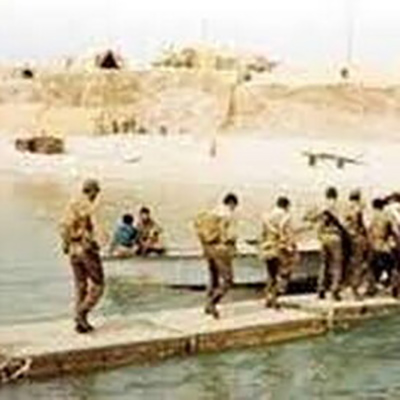Sites
Majnoon Island
Marzieh Abedini
187 Views
The Majnoon Island is one of the key oil-rich regions in southern Iraq. Capturing the Northern and Southern Majnoon islands was the main goal of Operation Kheibar, and defending them later became the focus of Operation Badr.
The Majnoon Island consists of two parts—Northern and Southern—covering a total area of 200 square kilometers.[1] Both islands are roughly pentagon-shaped.[2] The northern part contains the maritime and navigational zones, while the southern one is largely composed of land.[3]
Northern Majnoon Island is located about 15 kilometers from the Iraqi town of Al-Qurnah. Just west of the island lies the Basra–Amarah highway, a key corridor in Iraq. Located to the northeast of Northern Majnoon, the Iranian city of Hoveyzeh marks a point where Iran’s border cuts through the wetlands of the Hawizeh Marshes. The Tigris River flows west of the area, with the towns of Al-Qurnah to the south and Al-Uzair to the north.[4] The westernmost point of Northern Majnoon Island lies about 12 kilometers from the Iran–Iraq border and northeast of Iraq’s Zarwan River. Northern Majnoon is smaller than the Southern one.[5]
The Southern Majnoon is a horseshoe-shaped Island surrounded by water channels, rivers, and dense reed marshes.[6] The western edge of Northern Majnoon lies about 10 kilometers from the international border. The nearest point in Iranian territory is the Talaieh region. The island is located to the east of the Iraqi town of Al-Qurnah.[7] There are about 50 villages populated by local civilians around the Northern Island.[8]
The island is covered in marsh plants, especially thick reed beds, which attract tons of mosquitoes and make it a tough place for people to live. It is also a home to various animals such as herons, ducks, wild geese, rodents, snakes, dogs, and wild boars.[9]
Both islands have oil reserves.[10] There are also other facilities in the islands, including power transmission towers, radio and television relay towers, and paper manufacturing plants.[11] Iraq used the Al-Uzair–Majnoon Road to transport oil from the islands. This road, which cuts through the Basra and Al-Amarah provinces, was constructed in the marshlands of Hawizeh.[12]
Before the Iran–Iraq War, Iraq had been developing oil facilities and infrastructure projects in this area. However, the outbreak of war brought those projects to a stop.[13]
After more than three years of the outbreak of war, the Hawizeh Marshes were identified as a strategically viable route for a military operation. Because of the flooding and rugged terrain in the area, Iraqi forces did not expect an attack from Iranian troops in that direction.[14]
Operation Kheibar was launched on February 22, 1984, in the Hawizeh Marshes by 250 combat battalions of the Najaf Headquarters of the Islamic Revolutionary Guard Corps (IRGC) and the Karbala Headquarters of the Army, under the overall command of the Khatam al-Anbiya (pbuh) Central Command. This operation was marked by various innovations, including the construction of the Seyyed al-Shuhada (ra) Road through the marshes and Kheibar floating bridges. It also gave Iranians valuable experiences in employing Army Aviation (Havanirooz), naval transport assets, overcoming natural barriers, and resisting chemical attacks. Although the capture of the oil-rich Northern and Southern Majnoon islands was a significant achievement for Iran, extensive chemical bombardments by Iraqi forces significantly impeded the full realization of Iran’s pre-planned objectives.
In Operation Kheibar, Iranian Army Aviation, despite a lack of night-flying capabilities, successfully deployed over 19000 combatants to Majnoon islands during the night using more than 82 helicopters. Over 1700 tons of logistical equipment, artillery, and ammunition were also delivered, and more than 2000 wounded were evacuated.[15] This operation significantly damaged Iraqi forces, and the Majnoon islands, which hold some of Iraq’s largest oil reserves, were seized by Iranian troops, and Iraq was never able to take them back.[16]
In response to the Iranian victory, the Baathist regime increased the chemical and conventional bombardments[17] of the islands and nearby military units, using mustard gas and nerve agents.[18] Despite these brutal attacks, Iranian fighters showed remarkable resistance and several IRGC commanders were martyred or wounded on Southern Majnoon Island. Hamid Bakeri, Deputy Commander of the 31st Ashura Division, was declared missing in action (martyred), and Haj Ebrahim Hemmat, Commander of the 27th Muhammad Rasulullah (pbuh) Division, was martyred.[19] Also, Hussain Kharrazi, Commander of the 14th Imam Hussain (as) Division, lost his arm.[20]
Following repeated defeats, Iraq intensified aerial bombardments of Iranian cities, chemical attacks on Majnoon, and airstrikes on oil tankers and Iran’s maritime trade convoys in the Persian Gulf.[21]
After Operation Kheibar, Iraq took extensive defensive measures along the western edge of the marshes and the Tigris River. They included the construction of over 50 dirt dams, irrigation canals, and watercourses, building bridges, installing extensive barbed wire and minefields, deploying defensive forces, and establishing a new command center called the Special Command of East Tigris.[22]
One year later, on March 10, 1985, the Iranian forces carried out Operation Badr in the same marsh region, east of the Tigris River, aiming to destroy large numbers of enemy forces, taking full control of the Hawizeh Marshes, disrupting the Basra–Amarah highway, and responding to Iraq’s bombardments of civilian areas in Iran.
With strong support from the Air Force and Army Aviation, Iranian troops managed to capture areas east of the Tigris, including the Tarabeh Outpost, Iraqi headquarters, and the Khandaq Road. The Jowayber Bridge over the Tigris was blown up by Iranian fighters which disrupted the Iraqi logistics along the Basra–Amarah corridor. Despite intense air and artillery fire, the al-Mahdi (as) Battalion of the 43rd Imam Ali (as) Engineering Division (IRGC) built a 10-kilometer bridge from Southern Majnoon Island within 24 hours, restoring the logistical lines between frontline forces and support units. As a result, 3000 Iraqi troops were captured, and Iran’s position east of the Tigris was solidified.[23]
Mahdi Bakeri, Commander of the 31st Ashura Division, and Abbas Karimi, Commander of the 27th Muhammad Rasulullah (pbuh) Division, were martyred in this operation.[24]
Eventually, on June 25, 1988, Iraq recaptured the Majnoon islands.[25]
Even after thirty years, teams from the General Staff of Iran’s Armed Forces are still searching the Majnoon region for the bodies of the martyrs.
A film titled “The Epic of Majnoon” (Hamase-ye Majnoon) directed by Jamal Shoorjeh was produced in 1994 to depict the bravery and sacrifices of Iranian fighters in Majnoon islands.[26]
[1] Samiee, Ali, Karname-ye Tosifiy-e Amaliyathaye Hasht Sale Defa Muqaddas (Descriptive Record of the Operations of the Eight-Year Sacred Defense), Tehran, Moavenate Entesharat va Tablighat-e Namayandegiye Valiye Faqih dar Nirooye Zamini-ye Sepah-e Pasdaran, 1376, p. 168.
[2] Pourdarab, Saeed, Taqvime Tarikhe Defe Muqaddas (Amaliyat-e Kheibar) (Chronology of the Sacred Defense [Operation Kheibar]), Vol. 43, Tehran, Entesharate Markaze Asnade Enqelab-e Eslami, 1396, p. 264.
[3] Muhammadi, Soheila, Jazire Majnoon (Hamaseh: 4/4/1367) (Majnoon Island [Epic: June 25, 1988]), Dezful, Soheila Muhammadi, 4th ed., 1395, p. 49.
[4] Samiee, Ali, Ibid., p. 168.
[5] Pourdarab, Saeed, Ibid., p. 264.
[6] Muhammadi, Soheila, Ibid., p. 65.
[7] Pourdarab, Saeed, Ibid., p. 264.
[8] Samiee, Ali, Ibid., p. 168.
[9] Muhammadi, Soheila, Ibid., p. 48.
[10] Amaliyat-e Kheibar – Tasarof-e Jazayer-e Majnoon (Tarahi, Ejra, Natayej, Baztabha) (Operation Kheibar– Capturing Majnoon Islands [Planning, Execution, Outcomes, Implications]), Markaz-e Motaleat va Tahqiqat-e Jang-e Sepah-e Pasdaran-e Enqelab-e Eslami, Tehran, Markaz-e Motaleat va Tahqiqat-e Jang, 2nd ed., 1387, p. 33.
[11] Jazayeri, Masoud, Majnoon (Morori bar Amaliyat-e Kheibar va Badr) (Majnoon [Reviewing Operations Kheibar and Badr]), Qom, Entesharate Nasim-e Hayat, 1384, p. 31.
[12] Pourdarab, Saeed, Ibid., Pp. 263, 264.
[13] Samiee, Ali, Ibid., p. 168.
[14] Jazayeri, Masoud, Ibid., p. 14.
[15] Pourdarab, Saeed, Ibid., Pp. 11, 12, 463.
[16] Ibid., Vol. 44, p. 11.
[17] Ibid., Vol. 43, Pp. 735, 739.
[18] Jazayeri, Masoud, Ibid., Pp. 103–105.
[19] Ibid., p. 62.
[20] Amaliyat-e Kheibar – Tasarof-e Jazayer-e Majnoon (Tarahi, Ejra, Natayej, Baztabha) (Operation Kheibar– Capturing Majnoon Islands [Planning, Execution, Outcomes, Implications]), Ibid., p. 27.
[21] Pourdarab, Saeed, Ibid., Vol. 44, p. 11.
[22] Ibid., Vol. 55, p. 11.
[23] Samiee, Ali, Ibid., Pp. 98, 195–197.
[24] Jazayeri, Masoud, Ibid., p. 23.
[25] Muhammadi, Soheila, Ibid., p. 67.
[26] Farasati, Masoud, Farhange Filmhaye Jang va Defa Muqaddas-e Iran 1359–1391 (Iranian War and Sacred Defense Film Encyclopedia 1980–2012), Tehran, Saqi, 1392, Pp. 114, 115.





